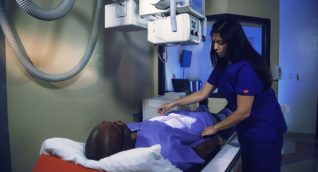X-ray exams use ionizing radiation to painlessly produce images of the inside of the body, including internal organs, connective tissue, and bone. The most familiar way of using X-ray is to diagnose broken bones, but X-rays are also used for many other kinds of diagnoses. Mammograms are a form of X-ray that examines the breast tissue while a chest X-ray is a common way to examine the lungs for cancer or infection. Bone densitometry also uses low-dose X-ray to determine bone mineral content and density.
X-rays are electromagnetic waves that are passed through your body and onto an X-ray plate which creates a digital image. Different body parts absorb different amount of radiation. Bones and any metal in your body absorb the most and appear white on the X-ray. Soft tissues appear as shades of gray and any air in your body appears black.
In addition to the simple X-ray exams discussed here, computed tomography (CT) also uses X-rays to produce cross-sectional images which can be combined with sophisticated computer processing to construct 3D images of the body. Fluoroscopy uses continuous X-ray to show moving images of the body. These exams, unlike X-ray, may require the use of a contrast agent.
X-ray exams are the oldest form of diagnostic imaging but still one of the best. They are a fast, easy, and noninvasive way to examine your body and require no special preparation.
X-ray tests are often the first imaging exam you will get to check for a medical problem. Here are some of the major conditions that X-ray is used to diagnose:
- Bone issues – Fractures, abnormalities, infection, arthritis, and cancer.
- Dental problems – Decay, abscesses, bone loss, and placement of wisdom teeth.
- Chest issues – Pneumonia, tuberculosis, enlarged heart, and lung cancer.
- Abdominal problems – Presence and location of foreign objects, problems of the digestive tract including the stomach, liver, intestines, and spleen.
Benefits
- X-ray exams are a quick, painless, and noninvasive way to detect various abnormalities and diseases.
- An X-ray exam can often provide enough information to diagnose a problem without using more invasive techniques.
- X-ray is very useful in emergency diagnosis and treatment.
- No special preparation is needed for these exams and they do not require the use of contrast.
- X-rays have no immediate side effects and do not remain in the body.
Risks
- Exposure to radiation may increase your risk for cancer, however, the amount of radiation used in general X-ray is small and unlikely to increase your cancer risk. The benefit of an accurate diagnosis far outweighs the risk.
- Women should try to avoid radiation exposure if they are pregnant. Inform your doctor or technologist if you are or think you might be pregnant.
- X-ray is typically done in an ARA imaging center and only takes a few minutes to complete.
- You will be asked to remove all metal and jewelry and, depending on the body area being examined, to change into a gown.
- You may be asked to wear a lead shield, often an apron, to protect certain parts of your body from radiation.
- Your technologist will position you on the X-ray machine. You may be standing next to an X-ray machine or lying down on an examination table, depending on the body area being examined.
- The technologist may use pillows and padded props to help position you in order to get the best exam.
- An X-ray machine will be placed near or over the area to be examined.
- You may be asked to hold your breath for a few seconds while the images are being taken. This is common for chest X-ray procedures.
- X-rays cause no sensations in the body and you can resume your normal activities immediately after the exam.
- Wear comfortable, loose fitting clothing. You may want to leave all jewelry, piercings, and any other metal objects at home.
- Make sure to tell your doctor if you have had a barium enema or any exam that used contrast recently. You may have to wait 10 to 14 days before undergoing a general X-ray since contrast can interfere with the results. Whether you must wait also depends on the body part being examined.
- Tell your doctor or technologist if there is any chance that you might be pregnant. It’s best to avoid X-ray tests during pregnancy. If the exam is absolutely necessary, precautions will be taken to minimize radiation exposure to the baby.
Appointments are not required for general X-ray exams. If you prefer to schedule an appointment, please use our online scheduling tool in the Patient Portal or you may call our scheduling team at (512) 453-6100 or toll free at (800) 998-8214. A provider referral is required.
A radiologist, a physician specifically trained to interpret radiological examinations, will analyze the images and send a signed report to the provider who referred you to ARA. The physician will then share the results with you.

 Back to Top
Back to Top